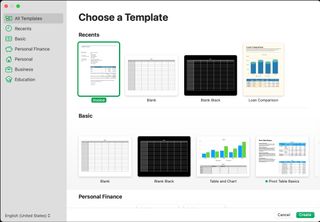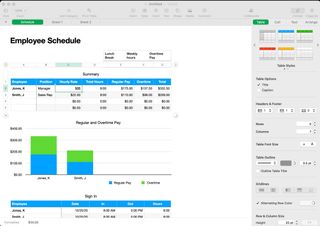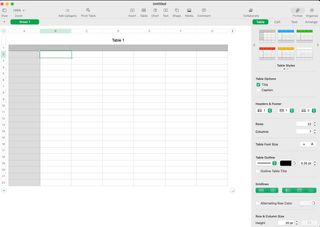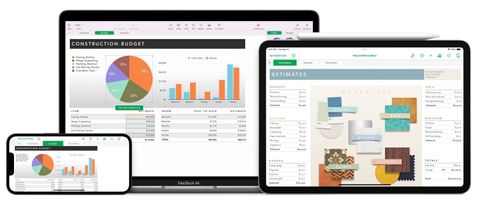TechRadar Verdict
Here's a terrific solution for anyone looking to add some creative flair to formulas and tables. Because it's only offered on Apple devices, its reach is limited, however, although there is a web-based version you can use on the fly.
Pros
- +
Ease of use
- +
Free on Apple devices
- +
Not just about tables
Cons
- -
Fewer functions than Microsoft Excel
- -
Limited reach
- -
Not very popular outside of Apple
Why you can trust TechRadar
First introduced in 2007 for Mac, Apple Numbers is the iPhone maker's answer to the best-selling Microsoft Excel. It's part of the iWork suite that also includes Pages and Keynote. Like those other apps, Apple Numbers is only offered on Apple devices, including Mac, iPad, and iPhone. However, there's also a web-based solution available to anyone with an iCloud account and a browser.
Its clean looks and ease of use have always been a strong selling point for Apple Numbers. But, unfortunately, because it's not available on Windows or Android, its usefulness is limited to only a handful of users.
Apple Numbers: Plans and pricing
Apple once charged for Numbers and the rest of the iWork suite. However, since 2017, the apps have been entirely free to use across multiple devices. In addition, Apple's iMovie and GarageBand also became free at the same time. You'll find Apple Numbers preinstalled on Mac and iPad; you can download your free copy for iPhone on the App Store.

Apple Numbers: Features
As any Microsoft Excel user will tell you, that software title uses tables as its primary container with other media types thrown in as optional add-ons. By contrast, Apple Numbers takes a free-form "canvas" approach where tables are just one of many types of media you can place on a document. This difference is reasoning enough for long-time Microsoft Excel users never to make the switch. And yet, Apple Numbers doesn't target those users. Instead, it's focused on creative types, students, and everyday home users who want to create eye-opening, sometimes splashy, documents that happen to include tables in most cases. As Apple explains currently on the Numbers webpage, with the app, "Everything adds up. Beautifully."
With this in mind, different features stand out about Apple Numbers that make it worth considering starting with its many templates.
Like its companion app, Apple Pages, Apple Numbers offers a range of mockups you can use to begin a new document. These take different forms, including personal finance, business, and education. Once you select a template, even a blank one, you can quickly add your information and make adjustments. It's also possible to create templates as starting points for future documents. Better still, you can access them on any device using iCloud. The many pre-packaged templates include ones for keeping track of net worth, shared expenses, there's even a travel planner and many more.
One of Apple Numbers' newest and most valuable features is reimagined forms. With a new setup, forms are much easier to create and customize. In addition, forms are available across multiple devices and look especially impressive on iPads, where digital form creation is perhaps most needed.

Moving on, although Microsoft Excel has more built-in functions, Apple Numbers isn't lacking here. It supports hundreds of functions, and the app's intuitive controls make it possible to perform complex calculations in just a few steps. You can also quickly explore patterns and trends with the Pivot Tables data analysis tool.
Meanwhile, iPad users with an Apple Pencil will find value from the handwriting tool that's built into every iWork app, including Apple Numbers. Scribble automatically turns your handwritten numbers and data into typed text. Imagine using this tool with digital forms that end-users might be asked to fill out at a school or organization — no typing required.
One of the biggest reasons to embrace Apple Numbers as an Apple-exclusive user is its integration with other Apple devices. Whether you're moving between iPad and Mac, iPhone to the web, etc., your documents are accessible and secure at all times — as long as you save the documents to iCloud. For example, you can start a Numbers document on your home MacBook Air, make edits on your iPad, then back again. As long as there's an internet connection, the data automatically syncs.
It's also essential to understand how Apple handles collaboration and document sharing in Apple Numbers. It's effortless to share content among other Apple users. You can now, for example, add a file to a shared iCloud Drive folder for viewing and editing among a team. The comments option makes it possible to see everyone's edits in real-time. Add comments or reply to others to create threaded conversations.
You can also share Numbers documents with Microsoft Excel users. To do so, however, you'll first need to convert the file in Numbers.
Finally, there are Smart Categories. The tool allows you to organize and summarize tables to provide additional insight quickly. For can use Smart Categories, for example, to group data by different values and date ranges. From there, it's just a matter of adding a few steps to create charts of the summarized data.
Apple Numbers: Interface and in use
Like other iWork apps, Apple Numbers doesn't get bogged down with something like Microsoft's tired Ribbon. Instead, you'll find the different options through a minimalistic toolbar and optional sidebars. This setup works because it's highly intuitive. For instance, even new users will understand what options are available under the toolbar's Insert, Table, and Chart headings. The same goes for the sidebar Table, Cell, Text, and Arrange tabs.
Apple Numbers: Support
Apple provides adequate support for Numbers through its website. There is also an active Apple Numbers community online, and Apple Books offers various guides, including many that are free.
Apple Numbers: The competition
Undoubtedly, nearly the entire world uses Microsoft Excel when it comes to spreadsheets. Apple understands this, and it's why it doesn't specifically target business users for Numbers.
Microsoft Excel and Apple Numbers are still not the only options available. Google Sheets, like Apple Numbers, is another free option. There's also Zoho Sheet, LibreOffice, and more.
Check out the best spreadsheet software and the best free office software.

Apple Numbers: Final verdict
There are two ways of looking at Apple Numbers and where it fits into the spreadsheet universe. First, if you're exclusively using Apple products and plan on collaborating only with Apple users, Numbers is a terrific choice. And because it's free, you have nothing to lose.
Everyone else is almost certainly going to be using Microsoft Excel, reluctantly or otherwise, and that's fine. Unlike Apple Numbers, Microsoft Excel is available across multiple platforms, including Windows, Mac, and mobile, making it ideal for most of the planet, especially those looking to do complex calculations that require many functions. It's not free, however, which is something those without a corporate account will have to consider.
We've also featured our Microsoft Excel review and a full iWork review.
Bryan M. Wolfe is a staff writer at TechRadar, iMore, and wherever Future can use him. Though his passion is Apple-based products, he doesn't have a problem using Windows and Android. Bryan's a single father of a 15-year-old daughter and a puppy, Isabelle. Thanks for reading!


